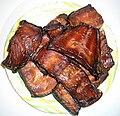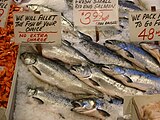Salmon as food

Salmon is a popular food. Classified as an oily fish,[1] salmon is considered to be healthy due to the fish's high protein, high omega-3 fatty acids, and high vitamin D[2] content. Salmon is also a source of cholesterol, with a range of 23–214 mg/100 g depending on the species.[3] According to reports in the journal Science, however, farmed salmon may contain high levels of dioxins. PCB levels may be up to eight times higher in farmed salmon than in wild salmon,[4] but still far below levels considered dangerous.[5][6] Nonetheless, according to a 2006 study published in the Journal of the American Medical Association, the benefits of eating even farmed salmon far outweigh any risks imposed by contaminants.[7]
Colour

in a market

| Nutritional value per 100 g (3.5 oz) | |||||||||||||||||||||||||||||||||||||||||
|---|---|---|---|---|---|---|---|---|---|---|---|---|---|---|---|---|---|---|---|---|---|---|---|---|---|---|---|---|---|---|---|---|---|---|---|---|---|---|---|---|---|
| Energy | 142 kcal (590 kJ) | ||||||||||||||||||||||||||||||||||||||||
6.34 g | |||||||||||||||||||||||||||||||||||||||||
19.84 g | |||||||||||||||||||||||||||||||||||||||||
| |||||||||||||||||||||||||||||||||||||||||
| Other constituents | Quantity | ||||||||||||||||||||||||||||||||||||||||
| Water | 68.50 g | ||||||||||||||||||||||||||||||||||||||||
| †Percentages estimated using US recommendations for adults,[8] except for potassium, which is estimated based on expert recommendation from the National Academies.[9] | |||||||||||||||||||||||||||||||||||||||||
Salmon flesh is generally orange to red, although there are some examples of white-fleshed wild salmon. The natural colour of salmon results from carotenoid pigments, largely astaxanthin but also canthaxanthin, in the flesh.[10] Wild salmon get these carotenoids from eating krill and other tiny shellfish. Because consumers have shown a reluctance to purchase white-fleshed salmon, astaxanthin (E161j), and very minutely canthaxanthin (E161g), are added as artificial colourants to the feed of farmed salmon, because prepared diets do not naturally contain these pigments. [citation needed]
In most cases, the astaxanthin is made chemically; alternatively it is extracted from shrimp flour. Another possibility is the use of dried red yeast or microalgae, which provide the same pigment. However, synthetic mixtures are the least expensive option. Astaxanthin is a potent antioxidant that stimulates the development of healthy fish nervous systems and enhances the fish's fertility and growth rate. Canthaxanthin may have negative effects on the human eye, accumulating in the retina at high levels of consumption.[10]
Today, the concentration of carotenoids (mainly canthaxanthin and astaxanthin) exceeds 8 mg/kg of flesh, and all fish producers try to reach a level that represents a value of 16 on the "Roche Colour Card", a colour card used to show how pink the fish will appear at specific doses. This scale is specific for measuring the pink colour due to astaxanthin and is not for the orange hue obtained with canthaxanthin. The development of processing and storage operations, which can be detrimental on canthaxanthin flesh concentration, has led to an increased quantity of pigments added to the diet to compensate for the degrading effects of the processing. In wild fish, carotenoid levels of up to 25 mg are present, but levels of canthaxanthin are, in contrast, minor.[10]
Products
The vast majority of Atlantic salmon available on the world market are farmed (almost 99%[11]), whereas the majority of Pacific salmon are wild caught (greater than 80%).
Canned salmon in the U.S. is usually wild Pacific catch, though some farmed salmon is available in canned form. Smoked salmon is another popular preparation method, and can either be hot or cold smoked. Lox can refer either to cold smoked salmon or to salmon cured in a brine solution (also called gravlax). Traditional canned salmon includes some skin (which is harmless) and bone (which adds calcium). Skinless and boneless canned salmon is also available.
Raw salmon flesh may contain Anisakis nematodes, marine parasites that cause Anisakiasis. Before the availability of refrigeration, Japanese did not consume raw salmon. Salmon and salmon roe have only recently come into use in making sashimi (raw fish) and sushi[citation needed].
Ordinary types of cooked salmon contain 500–1500 mg DHA and 300–1000 mg EPA (two similar species of fatty acids) per 100 grams[12]
Unlike most common farmed fish, bones of salmon are not easy to notice in the mouth because they are usually quite thin and not tough.
Salmon dishes
| Name | Image | Origin | Description |
|---|---|---|---|
| Gravlax | 
|
Nordic | Raw salmon cured in salt, sugar, and dill. Usually served as an appetiser, sliced thinly and accompanied by hovmästarsås (also known as gravlaxsås), a dill and mustard sauce, either on bread of some kind, or with boiled potatoes. |
| Lohikeitto | 
|
Nordic | A creamy salmon soup consisting of salmon fillets, boiled potatoes and leeks,[13][14] served hot with some dill. |
| Lomi salmon | 
|
Polynesian | A side dish consisting of fresh tomato and salmon salad. It was introduced to Hawaiians by early western sailors.[15] It is typically prepared by mixing raw salted, diced salmon with tomatoes, sweet gentle Maui onions (or sometimes green onion), and occasionally flakes of hot red chili pepper, or crushed ice. It is always served cold. Other variations include salmon, diced tomato, diced cucumber, and chopped sweet onion. |
| Lox | 
|
Jewish | A fillet that has been cured. In its most popular form, it is thinly sliced—less than 5 millimetres (0.2 in) in thickness—and, typically (in North America), served on a bagel, often with cream cheese, onion, tomato, cucumber and capers. Lox in small pieces is also often added and cooked into scrambled eggs, sometimes with chopped onion. |
| Rui-be | Japan | Salmon that is frozen outdoors, sliced like sashimi, and served with soy sauce and water peppers.[16] | |
| Salmon burger | 
|
A type of fishcake made mostly from salmon in the style of a hamburger. It is challenging to make and cook as the salmon requires a binder to make it stick together and is easy to overcook which makes it too dry.[17] Salmon burgers are especially common in Alaska where they are routinely offered as an alternative to beef hamburgers.[18] | |
| Salmon tartare | 
|
Appetiser prepared with fresh raw salmon and seasonings, commonly spread on a cracker or artisan style bread | |
| Smoked salmon | 
|
A preparation of salmon, typically a fillet that has been cured and then hot or cold smoked. Due to its moderately high price, smoked salmon is considered a delicacy. Although the term lox is sometimes applied to smoked salmon, they are different products.[19][20] | |
| Salmon sashimi | 
|
Japan | Sliced raw salmon served with garnishes. Usually eaten by dipping in soy sauce and wasabi. |
| Kippered salmon | Hupa, Karuk, Yurok | Salmon smoked using fruitwood until cooked on the outside but raw on the inside, then canned and pressure cooked. Can be seasoned with red pepper and other seasonings. |
| Further images |
|---|
|
Labelling of genetically modified salmon
In the United States, the Food and Drug Administration does not require labelling of genetically engineered salmon. However, in December 2015, members of the Alaska congressional delegation were able to insert language in a major spending bill that temporarily banned the sale of modified salmon until the FDA promulgated labeling guidelines.[21]
See also
Notes
- ^ "What's an oily fish?". Food Standards Agency. 24 June 2004.
- ^ "Dietary Supplement Fact Sheet: Vitamin D". National Institutes of Health. Archived from the original on 13 December 2007. Retrieved 13 December 2007.
- ^ "Cholesterol: Cholesterol Content in Seafoods (Tuna, Salmon, Shrimp)". Retrieved 13 December 2007.
- ^ "Global Assessment of Organic Contaminants in Farmed Salmon". Science (journal). 9 January 2004.
- ^ "Farmed vs. wild salmon -- which is better?". CTV News. Retrieved 28 April 2013.
- ^ "Risk-Based Consumption Advice for Farmed Atlantic and Wild Pacific Salmon Contaminated with Dioxins and Dioxin-like Compounds". doi:10.1289/ehp.7626.
- ^ "JAMA - Abstract: Fish Intake, Contaminants, and Human Health: Evaluating the Risks and the Benefits, October 18, 2006, Mozaffarian and Rimm 296 (15): 1885". Jama.ama-assn.org. 18 October 2006. doi:10.1001/jama.296.15.1885. Retrieved 18 March 2010.
- ^ United States Food and Drug Administration (2024). "Daily Value on the Nutrition and Supplement Facts Labels". FDA. Archived from the original on 27 March 2024. Retrieved 28 March 2024.
- ^ National Academies of Sciences, Engineering, and Medicine; Health and Medicine Division; Food and Nutrition Board; Committee to Review the Dietary Reference Intakes for Sodium and Potassium (2019). Oria, Maria; Harrison, Meghan; Stallings, Virginia A. (eds.). Dietary Reference Intakes for Sodium and Potassium. The National Academies Collection: Reports funded by National Institutes of Health. Washington, DC: National Academies Press (US). ISBN 978-0-309-48834-1. PMID 30844154. Archived from the original on 9 May 2024. Retrieved 21 June 2024.
- ^ a b c "Opinion of the Scientific Committee on Animal Nutrition on the use of canthaxanthin in feedingstuffs for salmon and trout, laying hens, and other poultry" (PDF). European Commission— Health & Consumer Protection Directorate. pp. 6–7. Retrieved 13 November 2006.
- ^ Montaigne, Fen. "Everybody Loves Atlantic Salmon: Here's the Catch..." National Geographic. Retrieved 17 November 2006.
- ^ (USDA)
- ^ Beatrice A. Ojakangas, (1992), «Scandinavian feasts: celebrating traditions throughout the year», Minnesota Pres, pp:220
- ^ Alan Davidson, (1979), «North Atlantic Seafood: A Comprehensive Guide with Recipes», Ten Speed Press, pp:360
- ^ "Polynesian Cultural Center: Hawaiian Luau Food". Retrieved 19 July 2009.
- ^ Chris Rowthorn (1 October 2009). Japan. Lonely Planet. pp. 582–. ISBN 978-1-74179-042-9. Retrieved 26 May 2012.
- ^ Mark Bittman (10 June 1998), The Minimalist; Burger With No Need of Ketchup, New York Times
- ^ Jim DuFresne, Greg Benchwick, Catherine Bodry (2009), Alaska, ISBN 978-1-74104-762-2
{{citation}}: CS1 maint: multiple names: authors list (link) - ^ "Acme Smoked Fish Corp. reprint of E. Kinetz. (22 September, 2002). So Pink, So New York. The New York Times". Retrieved 9 December 2007.
- ^ Kinetz, Erika (22 September 2002). "So Pink, So New York". The New York Times. The New York Times Company. Retrieved 9 December 2007.
- ^ Bohrer, Becky (17 December 2015). "Legislation Includes 'Frankenfish' Labeling Provisions". ABC News. Retrieved 21 December 2015.
Further reading
- Come back, salmon, By Molly Cone, Sierra Club Books, 48 pages, ISBN 0-87156-572-2 - A book for juveniles describes the restoration of 'Pigeon Creek'.
- The salmon: their fight for survival, By Anthony Netboy, 1973, Houghton Mifflin Co., 613 pages, ISBN 0-395-14013-7
- Trading Tails: Linkages Between Russian Salmon Fisheries and East Asian Markets. Shelley Clarke. (November 2007). 120pp. ISBN 978-1-85850-230-4.
- The Salmons Tale one of the twelve Ionan Tales by Jim MacCool
- "Last Stand of the American Salmon," G. Bruce Knecht for Men's Journal
External links
- Plea for the Wanderer, an NFB documentary on West Coast salmon
- Canned Salmon Recipes by Alaska Packers' Association, 1900 e-book with colour illustrations, available from Internet Archive
- Epicurean.com Salmon Recipes Collected recipes using Salmon at epicurean.com
- Salmon-omics: Effect of Pacific Decadal Oscillation on Alaskan Chinook Harvests and Market Price Kevin Ho, Columbia University, 2005.












